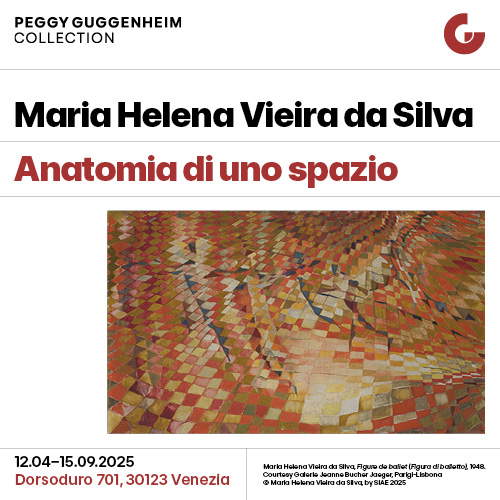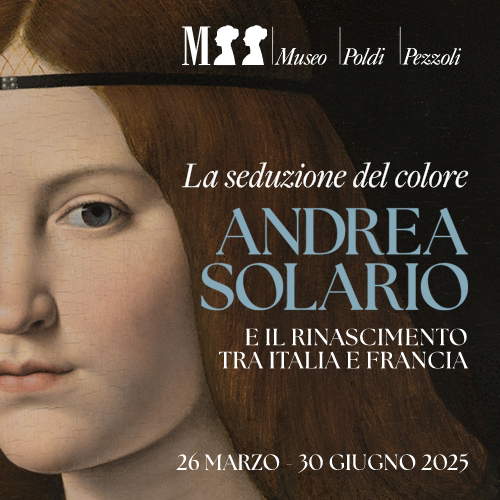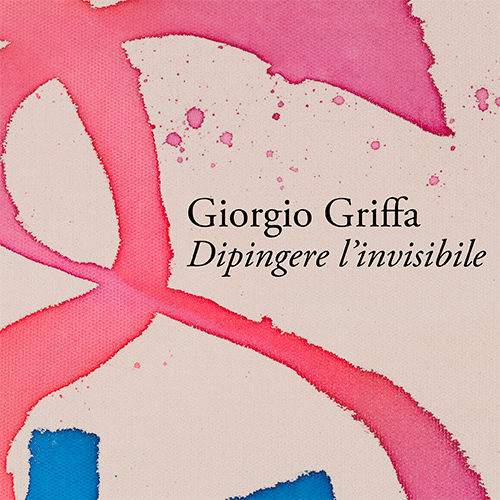Milan rediscovers Andrea Solario. This is what the beautiful exhibition at the Poldi Pezzoli Museum looks like.
One work alone, the Poldi Pezzoli’sEcce Homo , would be enough to understand what kind of artist Andrea Solari was. All it would take is that Christ so ideal and so deeply human, somewhere between Antonello and Leonardo, between the lenticular exactitude of the Sicilian and the nuanced softness of the Tuscan. That cascade of brown curls fading into the somber background would be enough; the thorns driven into the skin with feral brutality, the one that penetrates from the eyebrow arch, pierces the epidermis and grazes the eyelid, the glass tears, the delicacy of the modeling that gives body to the pectoral, the biceps, the hands bound by a rope that seems almost to come out of the surface, to make itself meet the relative, would be enough. He spoke of an Ecce Homo, in the seventeenth century, the French historiographer André Felibien, and considered it even better than the products of Leonardo da Vinci’s hand: “You have seen,” he wrote, "this Ecce Homo by Andrea Solario which is in the cabinet of the Monsieur Duc de Liancourt: although it is by a disciple of Leonardo, it is nevertheless worth more than many other paintings by Leonardo’s hand." We do not know which is this Ecce Homo mentioned in the seventeenth-century source. But it must not have been so far from the one in the Poldi Pezzoli.
It is here, in the ground-floor rooms of the Milanese museum, that a few days ago the first-ever monographic exhibition dedicated to Andrea Solari (or, in Latin, Andrea Solario, as we preferred to call him on this occasion) opened, too long hastily derubricated as one Leonardo among many, despite the fact that he, too, has known moments of exalted critical fortune, perhaps even beyond the ordinary. Ever since the presentation of the exhibition, which is curated by Lavinia Galli and Antonio Mazzotta, the economic estimates of Solario’s works recorded in the judicial inventory, dated 1879, of the works of Gian Giacomo Poldi Pezzoli, who bought five works by the Milanese artist, have been strongly emphasized: it then turns out that the Milanese artist’s Rest during the Flight into Egypt , which the public finds at the close of the itinerary, was valued at 45 thousand liras (it would be 210 thousand euros today), while Botticelli’s Madonna of the Book less than half that (20 thousand liras, 93 thousand euros today), and Pollaiolo’s Portrait of a Lady (at the time, however, attributed to Piero della Francesca) only 7 thousand liras (32 thousand euros). Five paintings by Andrea Solari in the collection of Giacomo Poldi Pezzoli, and now the museum’s pride and joy, have remained in the via Manzoni collection ever since. Only the Louvre has a comparable nucleus. Here then is why there could be no better place than this to host the first exhibition on Solario. His city, his museum.
In the 19th century, then, Solario was worth twice as much as Botticelli. Of the Milanese, writes Lavinia Galli in the exhibition catalog, fascinated at the time "the refined quality and cultural richness, ranging from Bellini to Leonardo, elevating him far above the simple followers of the Tuscan master. In contrast, Bernardino Luini, formerly exalted by Milanese art literature as a genius loci, is now criticized by nineteenth-century connoisseurs for a certain repetitiveness and a sacred stylistic independence.“ Andrea Solari, for Gustavo Frizzoni who was one of the leading critics of the late nineteenth century, is ”the most refined of those who produced the Lombard school of the Golden Age." Then, in the twentieth century, we kind of forgot about him. He stopped being a figure that stood out above the others and fell into the generic rank of the Leonardesque. And the rarity of his works did the rest: few things are known about Andrea Solari, there are no important public enterprises under his signature (the only room he had a chance to fresco was the chapel of the castle of Gaillon in Normandy, destroyed, however, during the French Revolution: Solario worked almost exclusively as a panel painter), none of his works has risen to the empyrean of popular icons, few major museums have his work in their collections, and most of his output is still in Milan today. He therefore did not have the credentials to be considered a major artist. The exhibition The Seduction of Color. Andrea Solario and the Renaissance between Italy and France therefore comes to fill a gap. Right from the title, to give an account of the fact that Solario was an international artist, an artist who moved between different cultures, between the Venetian one in which he was trained, the Milanese one from which he came and in which he later worked, and the French one: in France, moreover, Solario arrived before Leonardo da Vinci. It could be said that Andrea Solari was the artist who brought the Italian Renaissance to France. And his movements are the key that the curators of the exhibition offer the public to enter his production, with a subdivision of the exhibition itinerary that first follows his beginnings in the lagoon, after which he moves to France and then ends with Milan, albeit with a slight chronological mismatch, since between Venice and France there is a new Milanese passage, which the Poldi Pezzoli exhibition gives an account of in the concluding section. But no matter: the jump helps make the tour more readable.
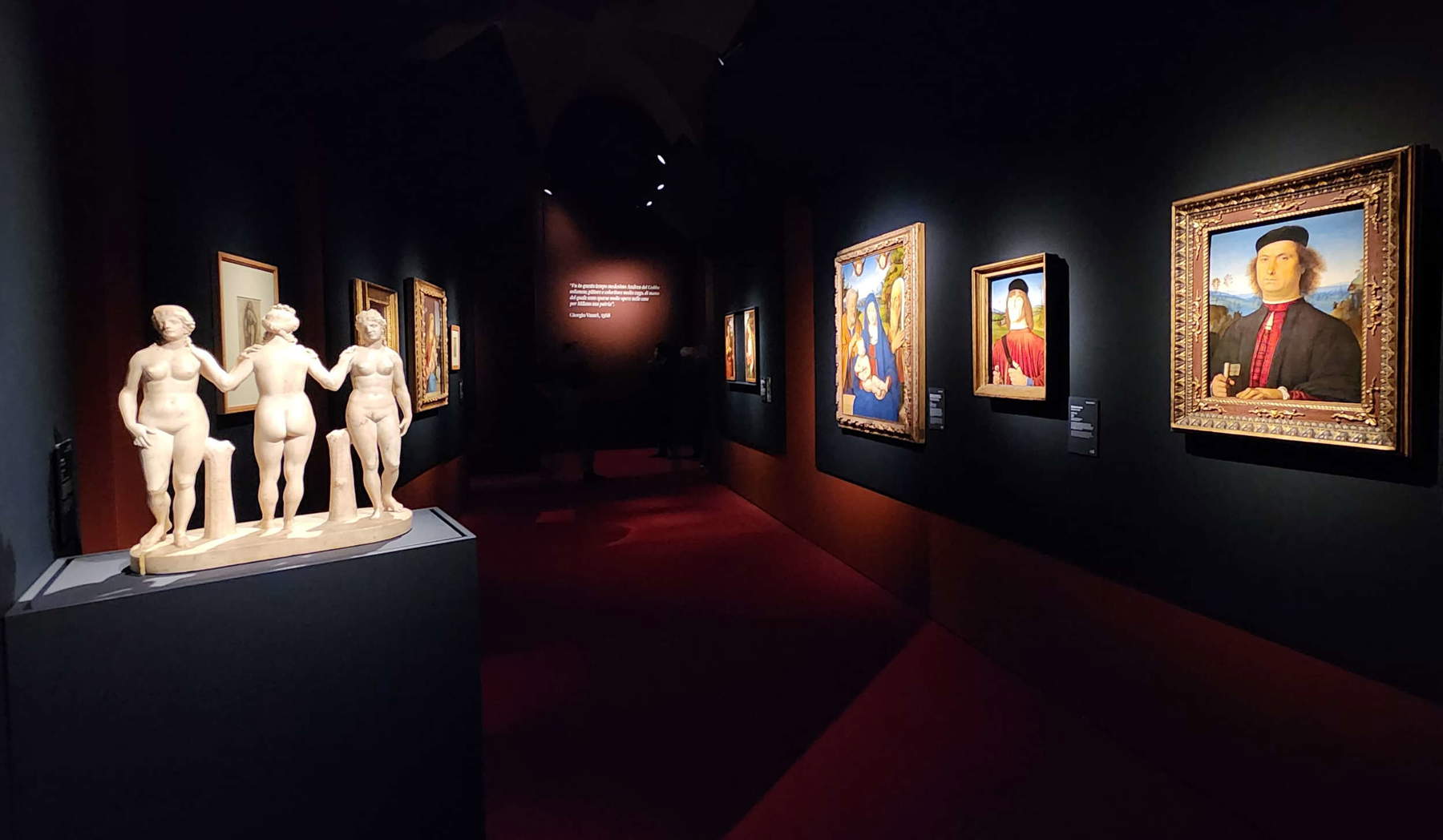
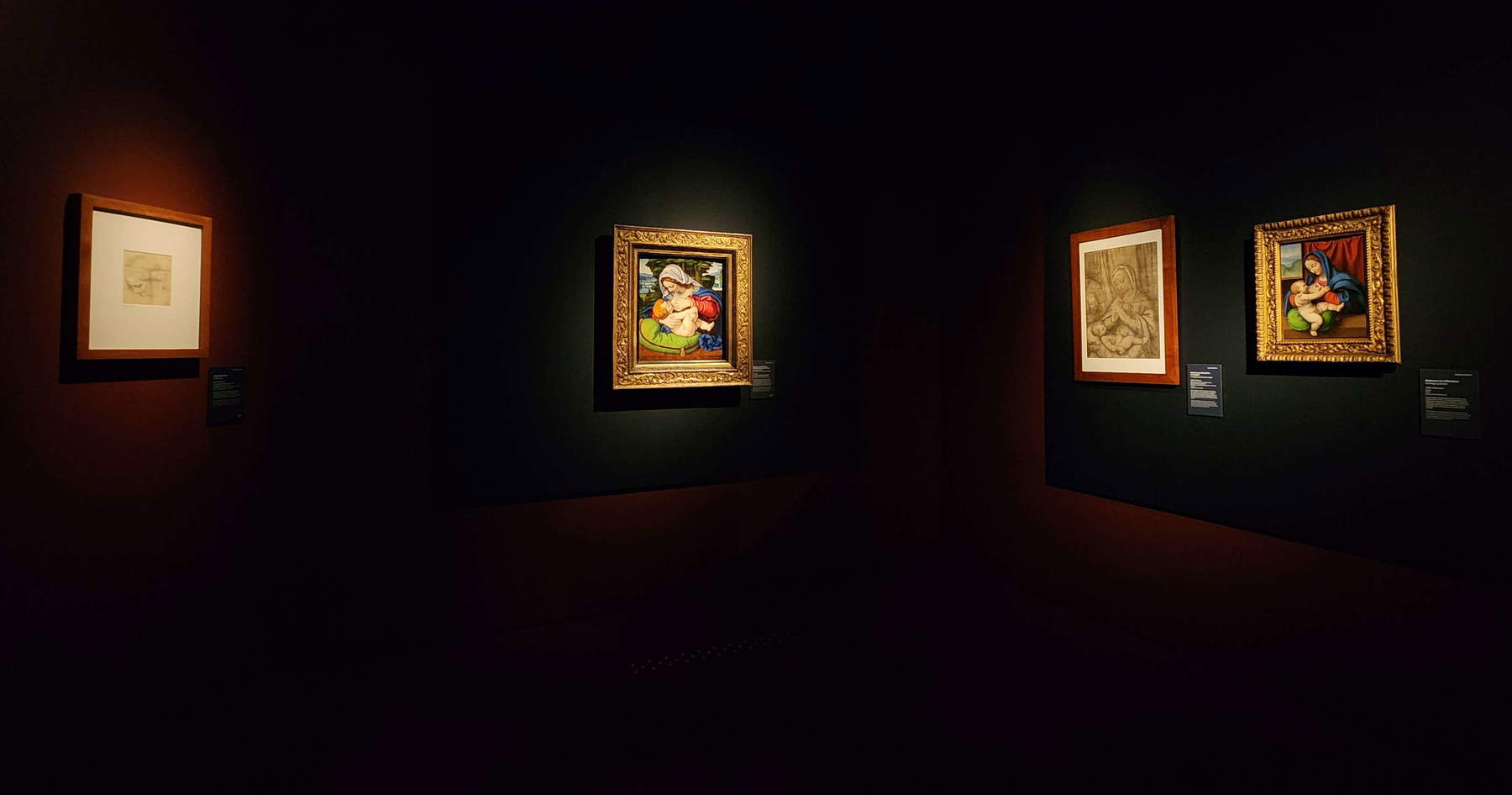
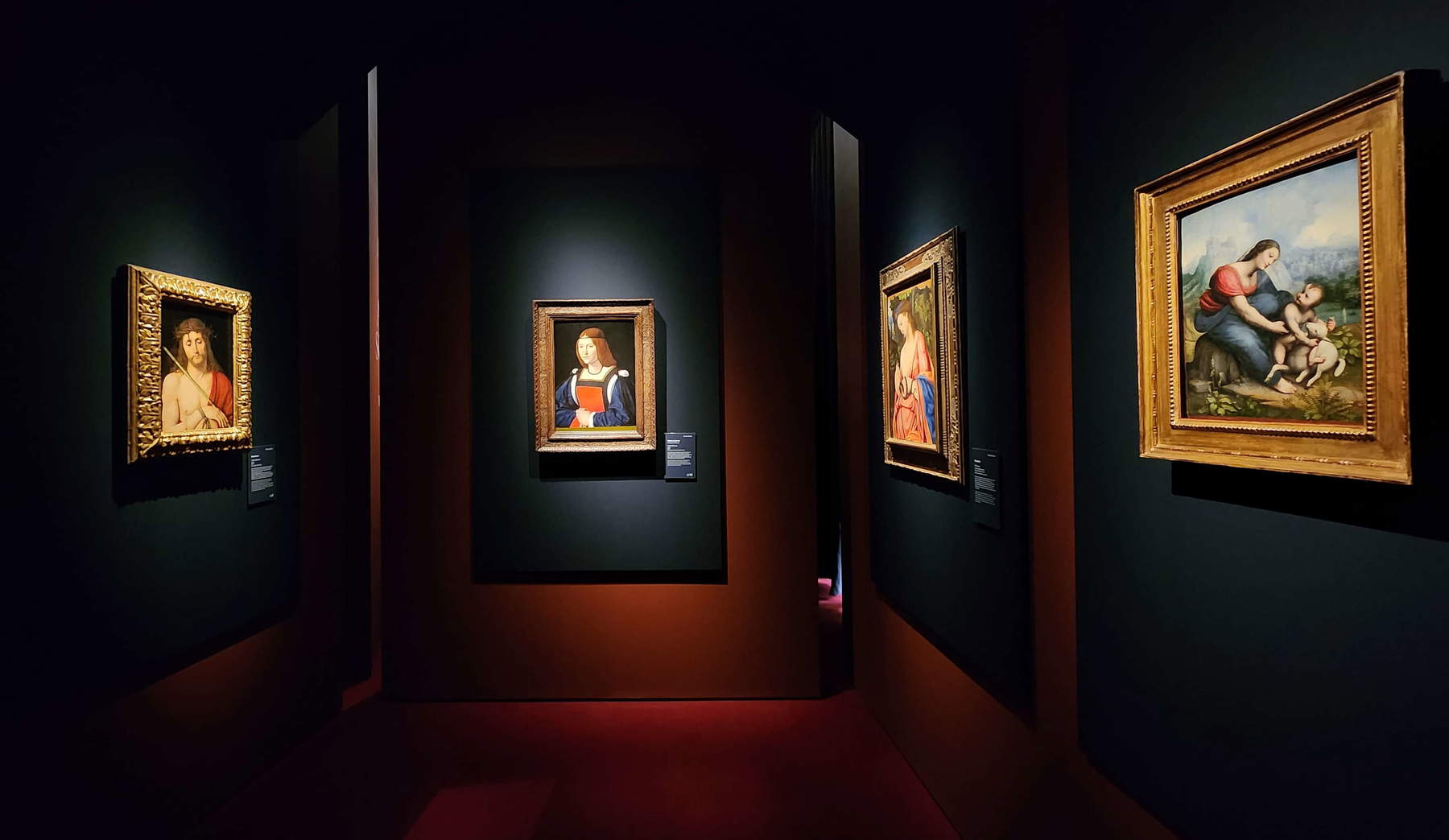
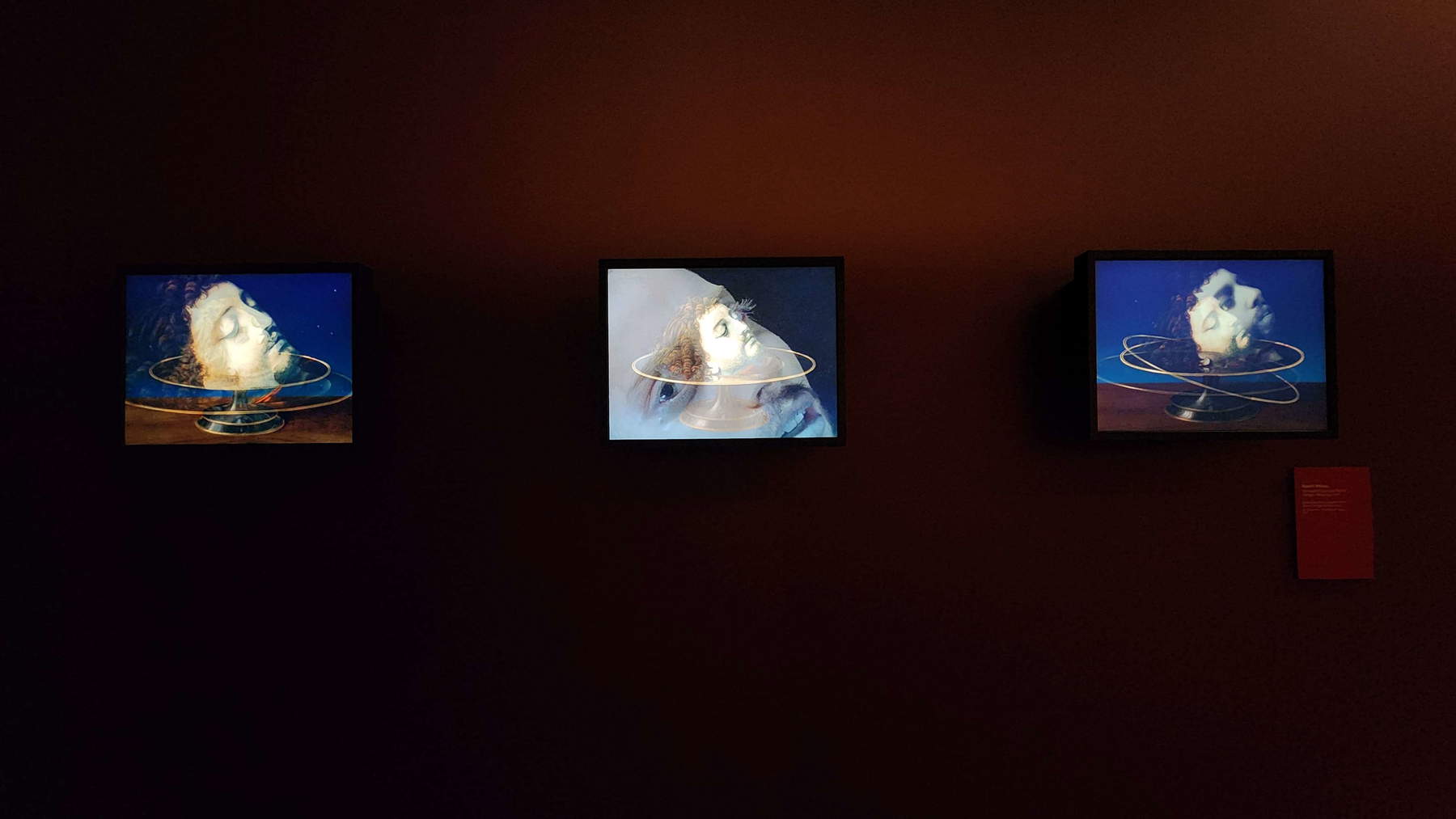
Frizzoni believed that Solario was a “connecting link” between the Venetian and Lombard schools. The opening of the exhibition, indeed, presents him to us as an artist who would already seem to be swimming in the waters of Antonello da Messina’s Venice: he is inevitably looked to by the Portrait of a Young Man lent by the Pinacoteca di Brera, the first work the visitor encounters on the tour. Andrea Solari was born in Milan, around 1470, to a family of artistic tradition, although the first traces of his activity lead to the lagoon, when he must have already been of age for some years. Yet, Federico Maria Giani suggests in the catalog, even this early evidence of Andrea’s flair, to be placed in the early 1490s, is measured against Leonardo da Vinci and in particular the Portrait of a Musician , without which it would be difficult to explain the cut of the portrait, with the half-length bust that allows a glimpse of the hand, and even “the accentuated bone structure of the cheekbone,” the scholar writes. It is clearly a work produced in Milan, because the debt to Leonardo’s Musico is strong, but the Antonellesque component is also clear (a pity not to have both in the exhibition): how to explain this early convergence? In only one way: Solario had been interested in Antonello’s research before moving to Venice, had meditated on what was available of him in Milan, and then had gone to the lagoon to deepen those researches, so much so that the later portraiture is fully cast in this context: look then at the Ritratto d’uomo, an excellent loan from the National Gallery in London, in dialogue with the portrait from Braid. Away with the gloomy background, takes over a verdant, clear landscape, bathed in crystalline light, explicable only by a careful reading (caught for the first time in 1965 by Luisa Cogliati Arano) of the Portrait of Francesco from Perugino’s Works , executed in all probability in Venice, where Perugino stayed several times between 1494 and 1497, where the Florentine Francesco delle Opere passed away in 1496, and where Solario himself was working during that very turn of the year. The resemblance of the landscape is striking, and the Poldi Pezzoli exhibition offers, for the first time, the rare chance to see the two works, one from London and the other from the Uffizi, paired on the same wall-one of the exhibition’s best qualities is the pinpoint punctuality of the loans. Between the two paintings, Mazzotta notes, “there are numerous points of compositional contact: the cut at waist height, the figure-landscape relationship, the small trees acting as wings, and even the right hand in the corner and resting on a parapet (in Perugino’s case a thin strip of it can be glimpsed).”
On the opposite wall, however, it is in the realm of the sacred that another direct confrontation takes place, that between Andrea Solari and another Leonardo, Giovanni Antonio Boltraffio, the artist who often mediated between Leonardo and Solario, “guaranteeing a distance,” Mazzotta writes, “that perhaps allowed Solario not to burn himself, as a young man, by coming too close to the master’s light (which happened to others instead: see Marco d’Oggiono).” The Madonna between St. Joseph and St. Simeon in the Brera Art Gallery is Andrea Solari’s first signed and dated work and is also believed to be his last Venetian work: the artist signs himself “Andreas Mediolanensis,” or “Andrea milanese,” a sign that at the time (the work bears the date 1495) he was still operating out of his hometown (but beyond this element, we know that in ancient times the church was located in the Dominican church of San Pietro Martire in Murano): it is painting that rereads the tradition of sacred Venetian conversations, that reasons on the works of Giovanni Bellini, of Cima da Conegliano, of Carpaccio, on the basis, however, of a Lombard substratum that resurfaces after it seemed almost to have been reposed in the London portrait: the comparison with Boltraffio’s Madonna is to prove beyond any doubt that the references, in modeling the bodies and composing the poses of the two main protagonists, of the Madonna seated on the parapet while holding in her hands a blond, plump baby boy, are robustly Leonardesque. In all this, it would remain to place the Madonna of the Carnations, also a Lombardian and Venetian work, a work with a Leonardesque spirit but imbued with Bellini-esque hints (the landscape beyond the window, first of all, which has nothing to do with Leonardo’s landscapes, and indeed has a profoundly Giorgionesque flavor, as Mazzotta convincingly argues by juxtaposing it, in the catalog, with the’Idillio campestre from the Musei Civici in Padua) and yet also looks to Dürer since the pose is the exact counterpart of the German’s Madonna of the Monkey (in the exhibition it is displayed next to him). A difficult work to place in Andrea Solari’s cursus because it is stiffer than even the Portrait of a Young Man , which, too, is supposed to be one of his earliest works. A work, however, that can be imagined as having been executed in Venice, at a time when Solario perhaps tended more to reflect on his lagoon references than those at home.
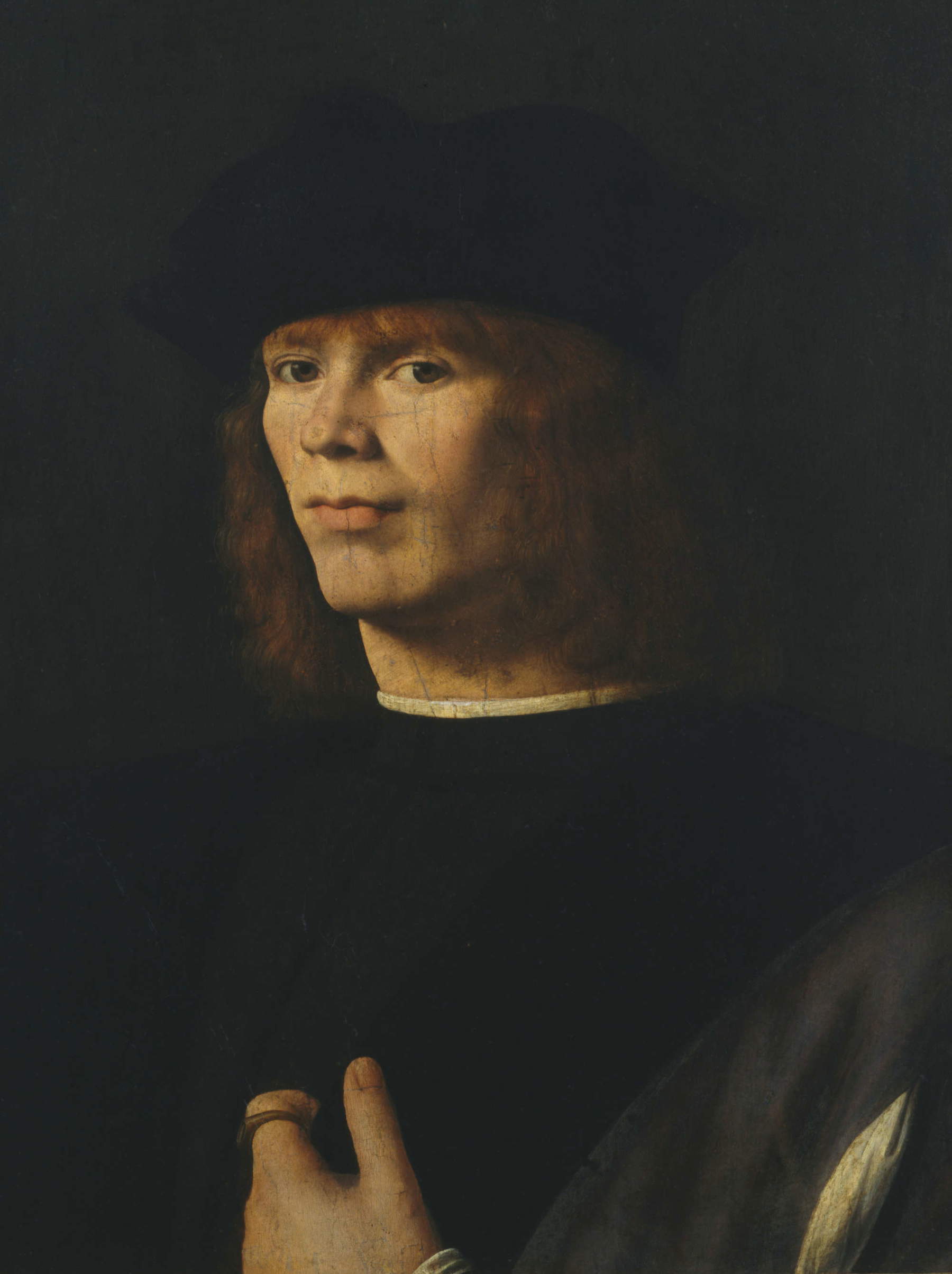
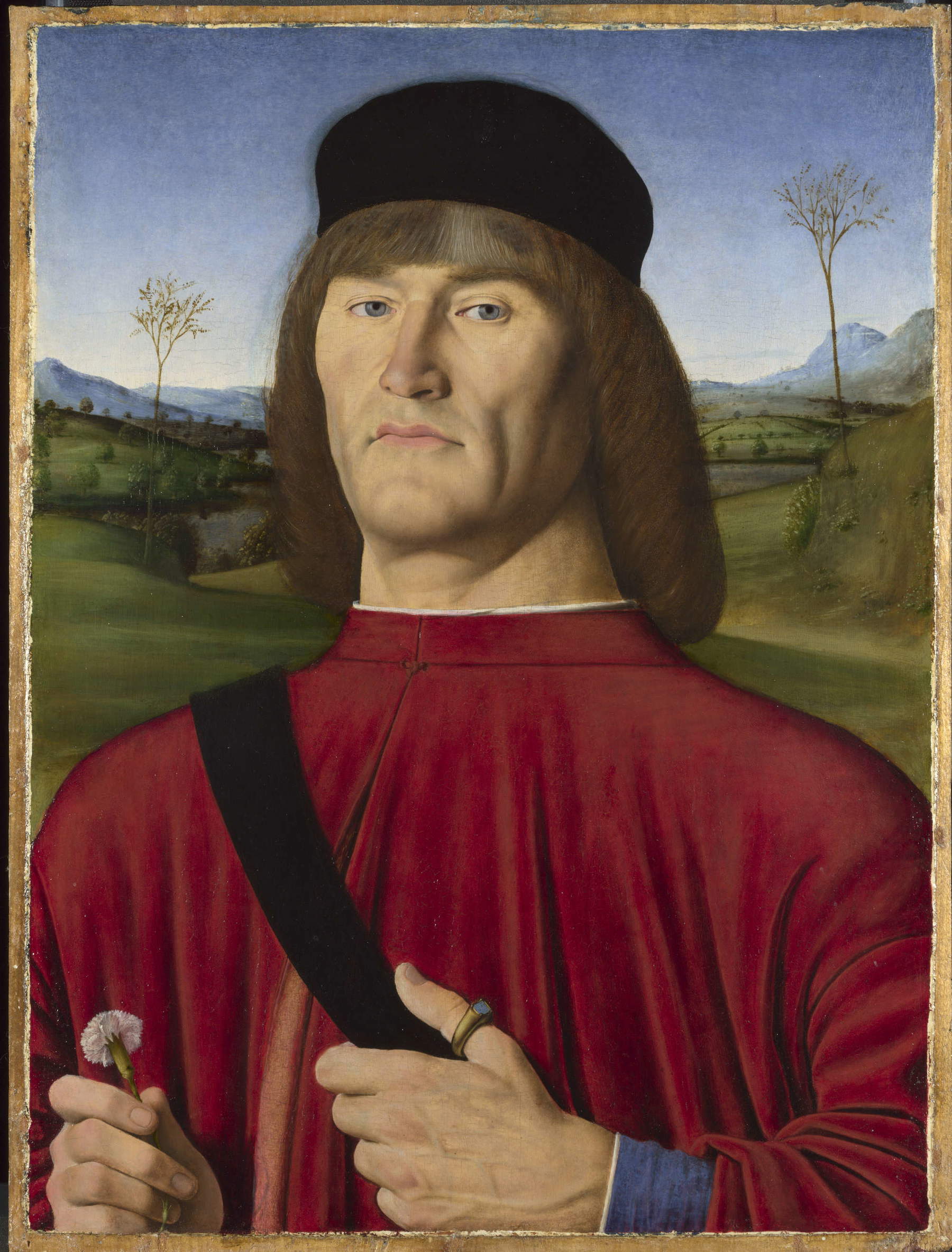
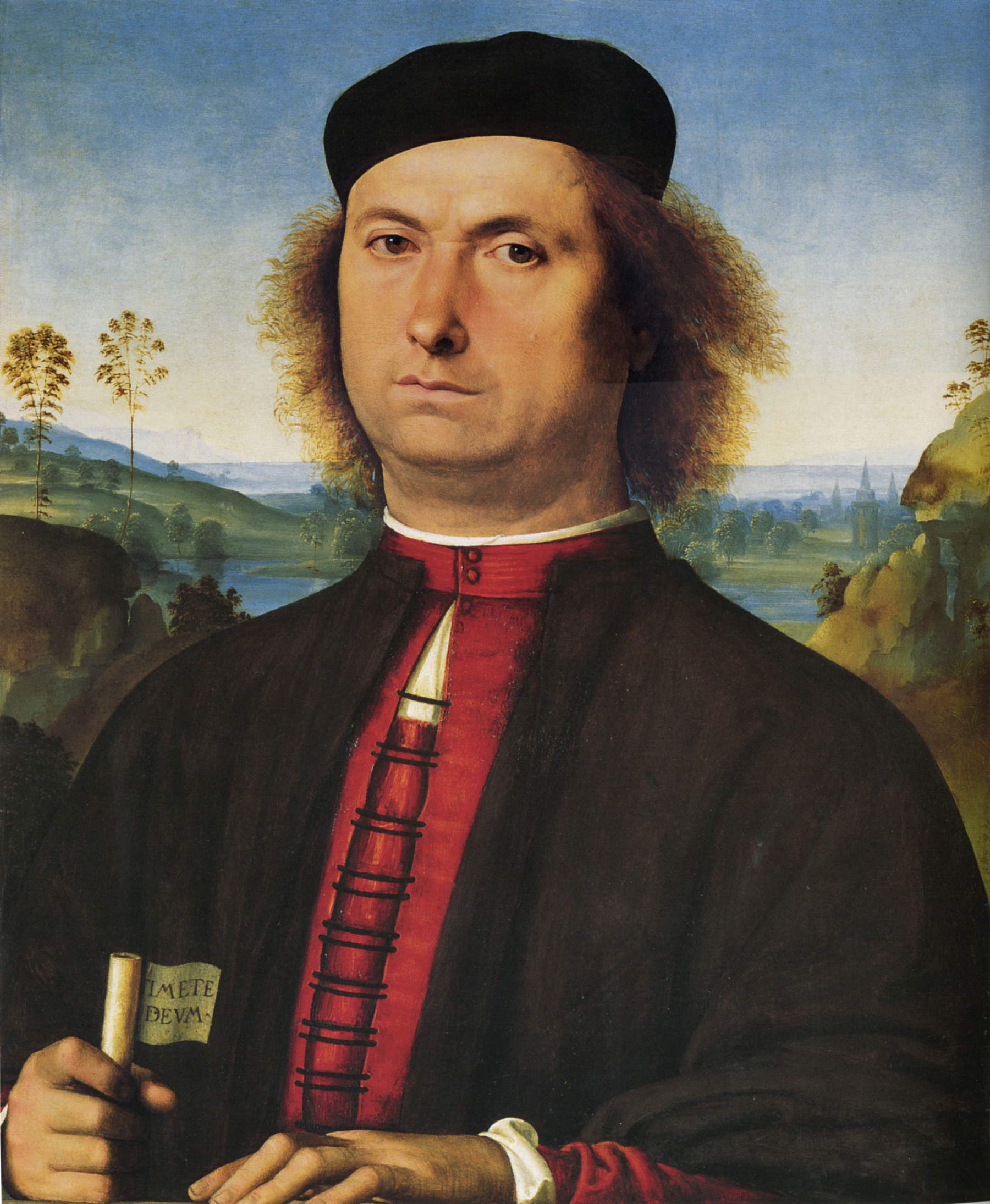
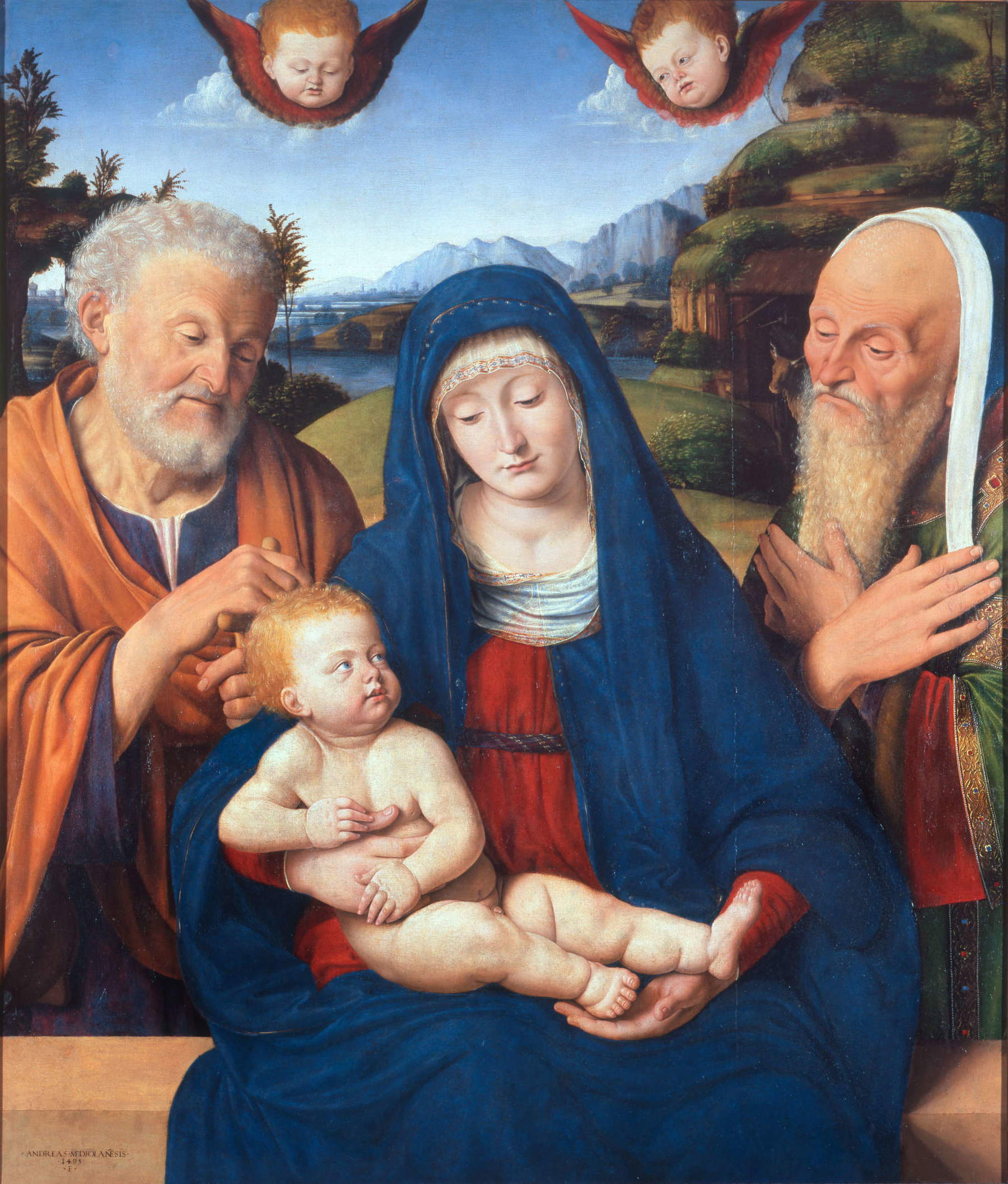
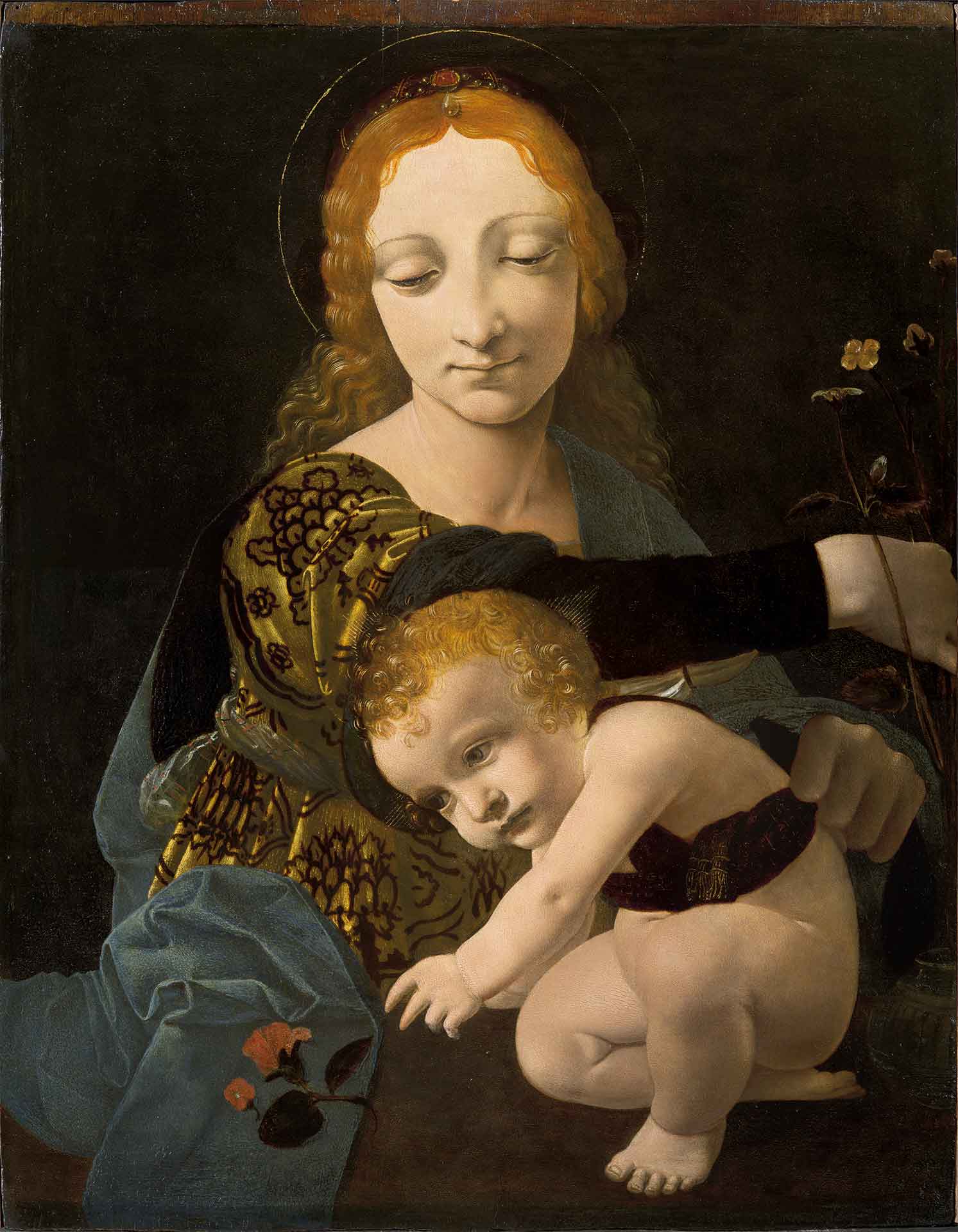
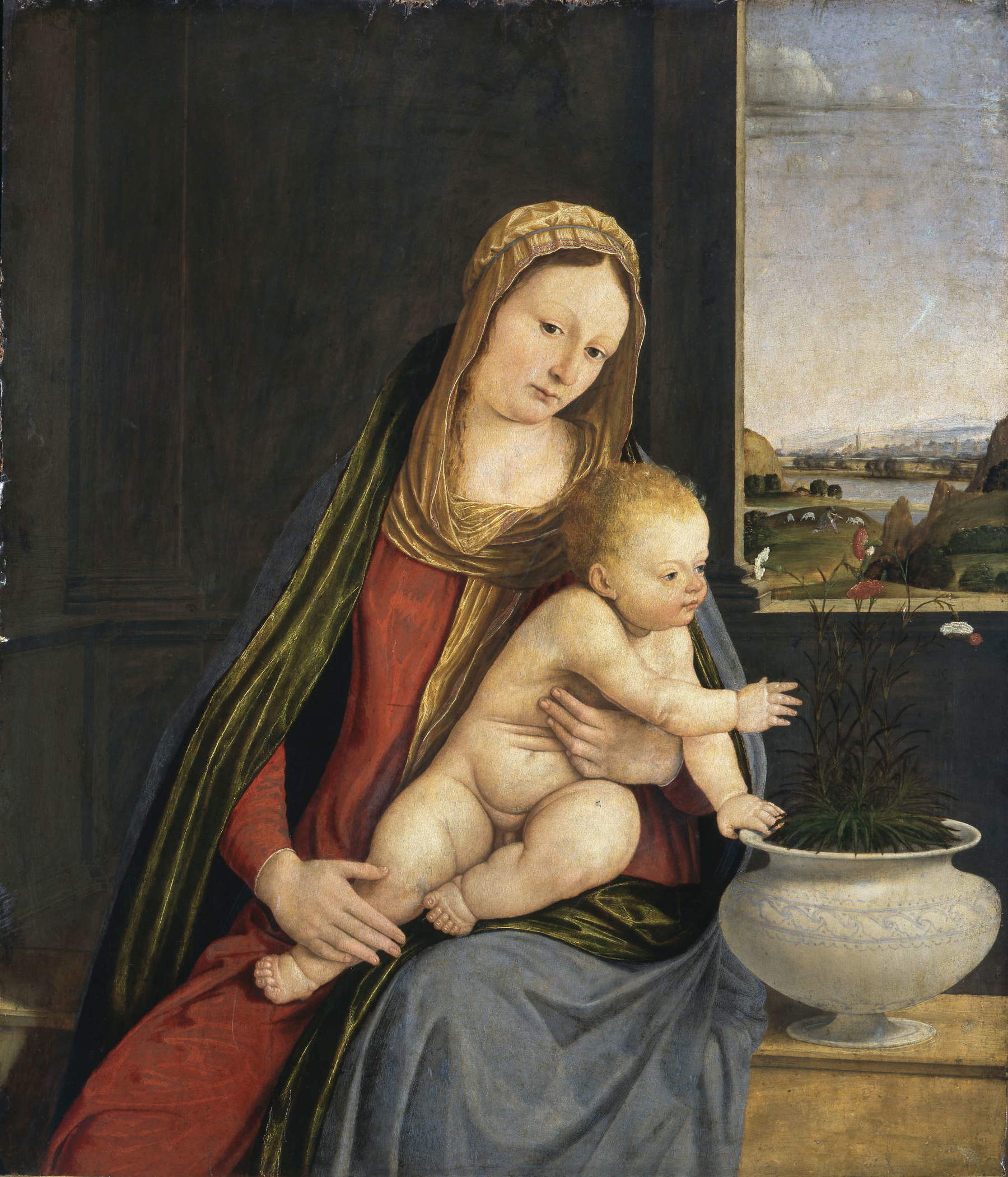
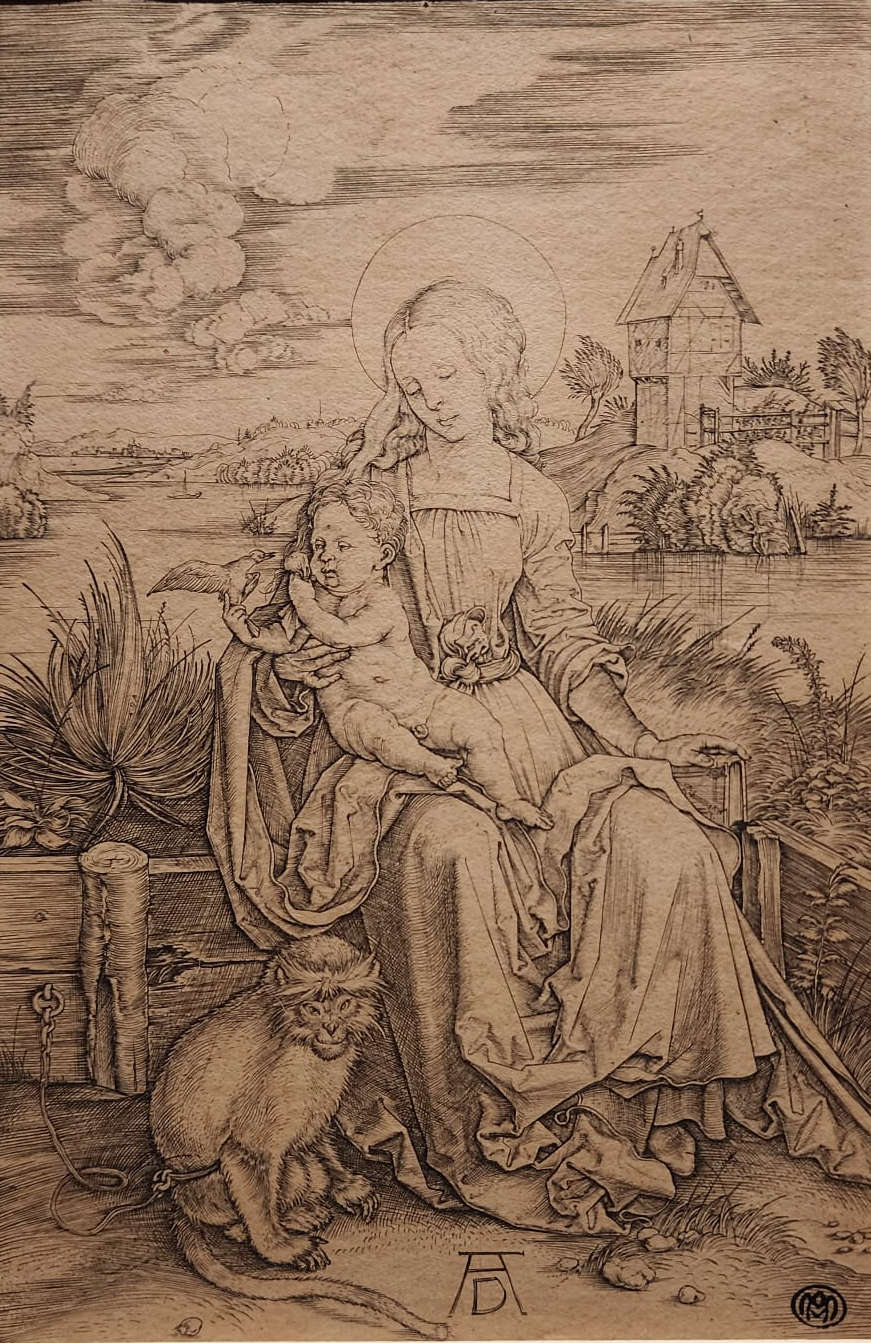
And then, with a jump, here in 1507 is the call to Normandy. When, in 1500, Ludovico il Moro was deposed by the French, Andrea Solari was among the few artists who did not leave Milan: we know this from documents. On the contrary, he is among the artists who bond with the new rulers of the city, and probably for three years, from 1507 to 1510, his activity moved to France although, as mentioned, nothing remains of his major undertaking, the decoration of the chapel of the castle of Gaillon, destroyed in 1799. Much else remains, however. Meanwhile, the portrait of his patron, Charles d’Amboise, French governor of Milan, who had called him to Normandy. It is a sort of male version of the Mona Lisa, one might say (it should be pointed out, however, that in the exhibition it is displayed with a question mark next to Solario’s name: many doubts about the attribution, although the name of the exhibition’s protagonist seems to the curators and their collaborators the most likely). And then, some of the most prized fruits of his hand: in the exhibition we begin with the Head of the Baptist, exhibited together with his drawing and executed in 1507, probably for Charles d’Amboise, masterful for the rendering of the metal surface of the elevation on which the saint’s head rests, for the precision of those reflections among which one can observe, if one pays attention, even a human face, probably Solario’s self-portrait. A very fortunate work, of which numerous copies and derivations are known: it means that even in ancient times there was a strong consideration for Solario. Solario himself would also have experimented on the theme, as attested by the Salome receiving the head of St. John the Baptist arriving from the Kunsthistorisches Museum in Vienna, a painting steeped in Milanese culture (comparisons with Bramantino have also been advanced), but also open to other suggestions, “with its decorative and precious minuteness of Flemish flavor and the compact and glazed drafting” (so Giovanni Renzi). And then, perhaps Andrea Solari’s most famous work, thenewly restored Madonna of the Green Cushion : having removed the yellow patina that obscured it (and made it so similar to the Mona Lisa), it has returned to show itself with colors compatible with those the painting must have had originally. A work signed “Andrea de Solario,” copied since the 16th century, almost revered three centuries later, a painting that is fundamental for reconstructing the entire activity of the Milanese painter (it has not been said, but the attributional debate on some of his works, which has nowhas settled down, has known moments of intense vivacity in the past), the Madonna of the Green Pillow is attested in France as early as 1617, the year to which dates the news of the gift with which the Conventual Minors of Blois paid homage to Maria de’ Medici, giving her precisely the Solario panel. The Virgin, caught breastfeeding the Child, leans on the parapet that returns often in Solario’s art, although paradoxically the scene is set in an outdoor setting, as if the Madonna paused over a low wall while in a garden, in that meadow that opens toward the river in the distance. The huge green pillow alludes to the Passion of Christ, as a symbolic reference to sleep, then death. The work is exemplified on the model of the Madonna Litta traditionally attributed to Leonardo da Vinci (in the catalog, however, there is a tendency to assign it to Boltraffio) and is one of the most “Leonardesque” of Solario’s compositions, which opposes the somewhat algid whiteness of the Virgin with the natural gesture, rendered with supreme grace, of the hand that offers the breast to the Child (the head turned toward the breast is, the curators note, a supreme piece of virtuosity), and above all the spontaneity of the child who takes his foot with his little hand. A composition that reworks the results achieved by Solario with the other beautiful Madonna with the child resting on the green cushion, the one in the Poldi Pezzoli, which in turn demonstrates a careful and original reading of the Litta Madonna, more coherent than that of the Madonna of the green cushion (the one in the Poldi Pezzoli is set in an interior), but also less revolutionary, if one can say so.
The conclusion, in the third room, is for his last Milanese years: in fact, Andrea Solari disappears in 1524, along with his brother Cristoforo (whose sculpture depicting the Three Graces is on display in the first room). On his return from Normandy, Andrea’s references are again updated: the Cleopatra, his only known work of mythological subject matter (and a suffering work, especially after undergoing transport from panel to canvas), while not renouncing the Leonardesque framework, reinterprets the landscape on the basis of what was’was being produced in early 16th-century Venice (it is hard not to think, for example, of the rocky walls of the Philosophers or Giorgione’sHomage to a Poet ), but also in the light of the novelties of the Milanese scene, beginning with the statuesque proportions that suggest, for example, a Bramantino. There is room then to present Andrea Solario again as a virtuoso of portraiture, as well as a painter appreciated by institutions (the portrait of the ducal chancellor Gerolamo Morone, different from those of the early years because it is mediated by contact with Lorenzo Lotto, can be considered a pinnacle of Lombard portraiture in the early sixteenth century). There is room, moreover, for a further comparison with Leonardo (albeit through a follower, Cesare da Sesto, by whom a copy of the St. Anne group is exhibited, but without St. Anne): the Rest during the Flight into Egypt, the last signed work of Andrea Solari known to date, dated 1515, reinterprets with delicate composure, cloaked in Nordic tones, the inventions of Leonardo da Vinci and is said by Lavinia Galli to be the “masterpiece of the maturity of the author” who arrives here at “elaborating a personal and lyrical style” perhaps capable, according to the curator, of having attracted Correggio engaged to paint the altarpiece once in the church of San Francesco in Parma and now in the Uffizi. And then, before the dismissal, here is the Ritratto di dama andEcce homo dialoguing on two adjoining walls. OfEcce Homo, it was mentioned at the opening: an admirable sample of Andrea Solario’s best talents, an example of perfect modeling, a fusion of dramatic intensity and anatomical study, a summa of the painter’s experiences while traveling between the Veneto and Lombardy while the winds of Flanders blew across the Po Valley. Work that has no fear of rivaling Antonello da Messina’s better Ecce homo , more famous than Andrea Solari’s. Work that entices one to linger over every detail, the thorns, the strands of blood, the curls of the beard, the eyelids reddened by tears. Work that introduces, finally, the Portrait of a Lady that closes the exhibition, long attributed to Boltraffio. Like the Madonna of the Green Cushion , it underwent restoration on the occasion of this exhibition, which restored new legibility to the panel, but nothing could against the ravages of time that have compromised some elements (above all the red fabric on the chest). The restoration has, however, made it possible to give new relief to the elements that did not suffer from the weakening of the film, starting with the lower part of the sleeves: it is here, in this iridescent damask of ultramarine blue that the last, indispensable piece of virtuosity in this exhibition is to be observed.
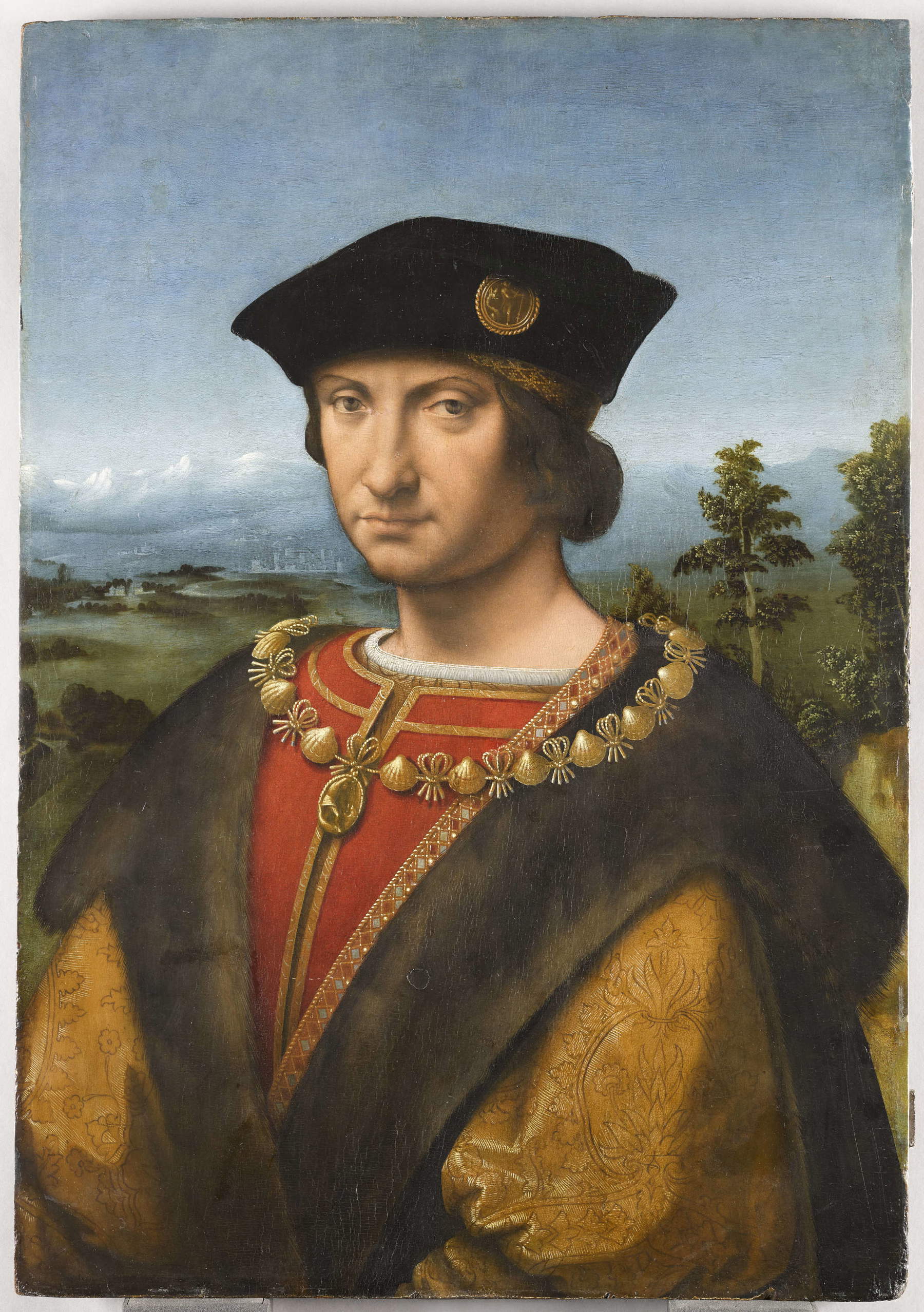
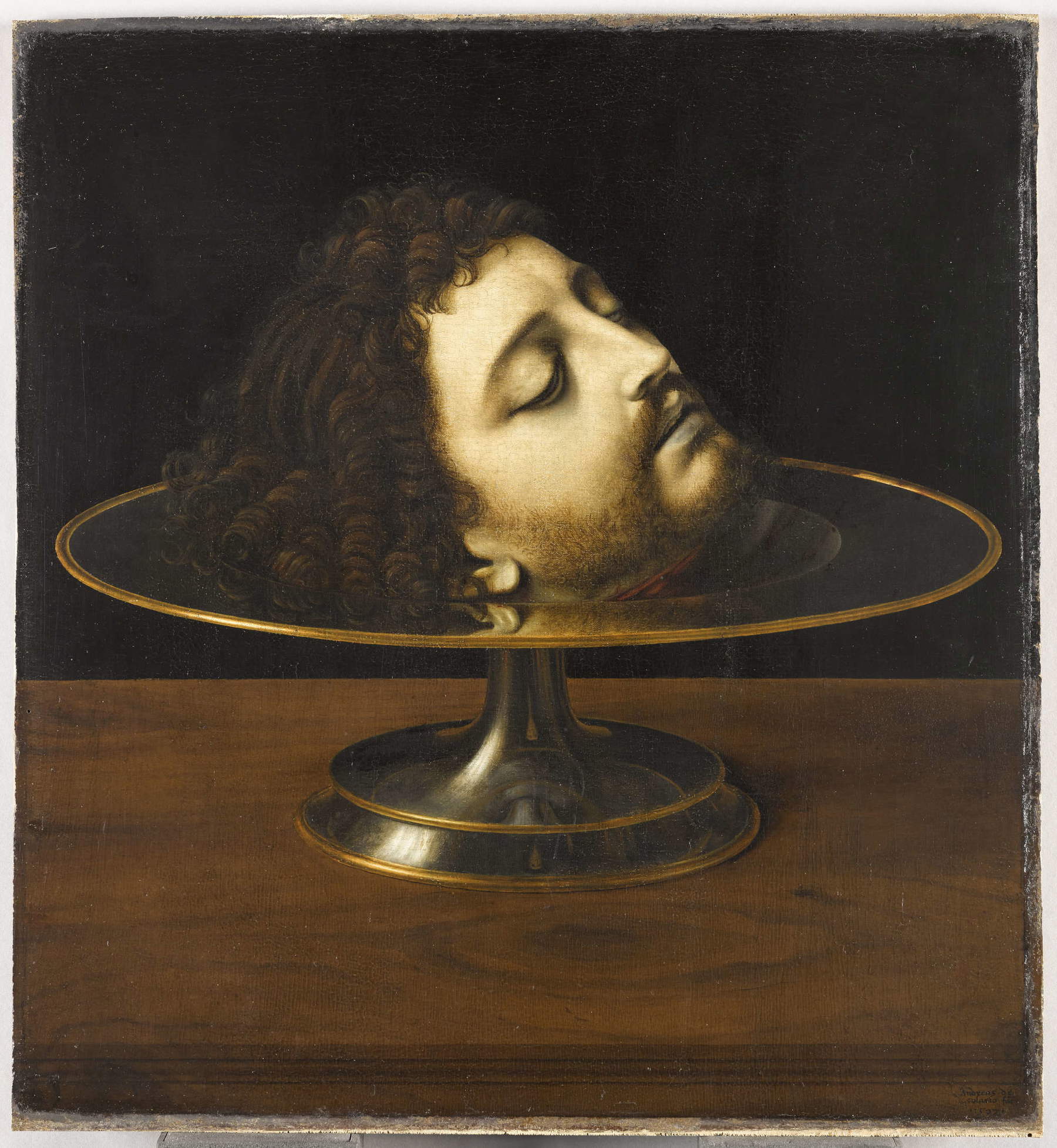
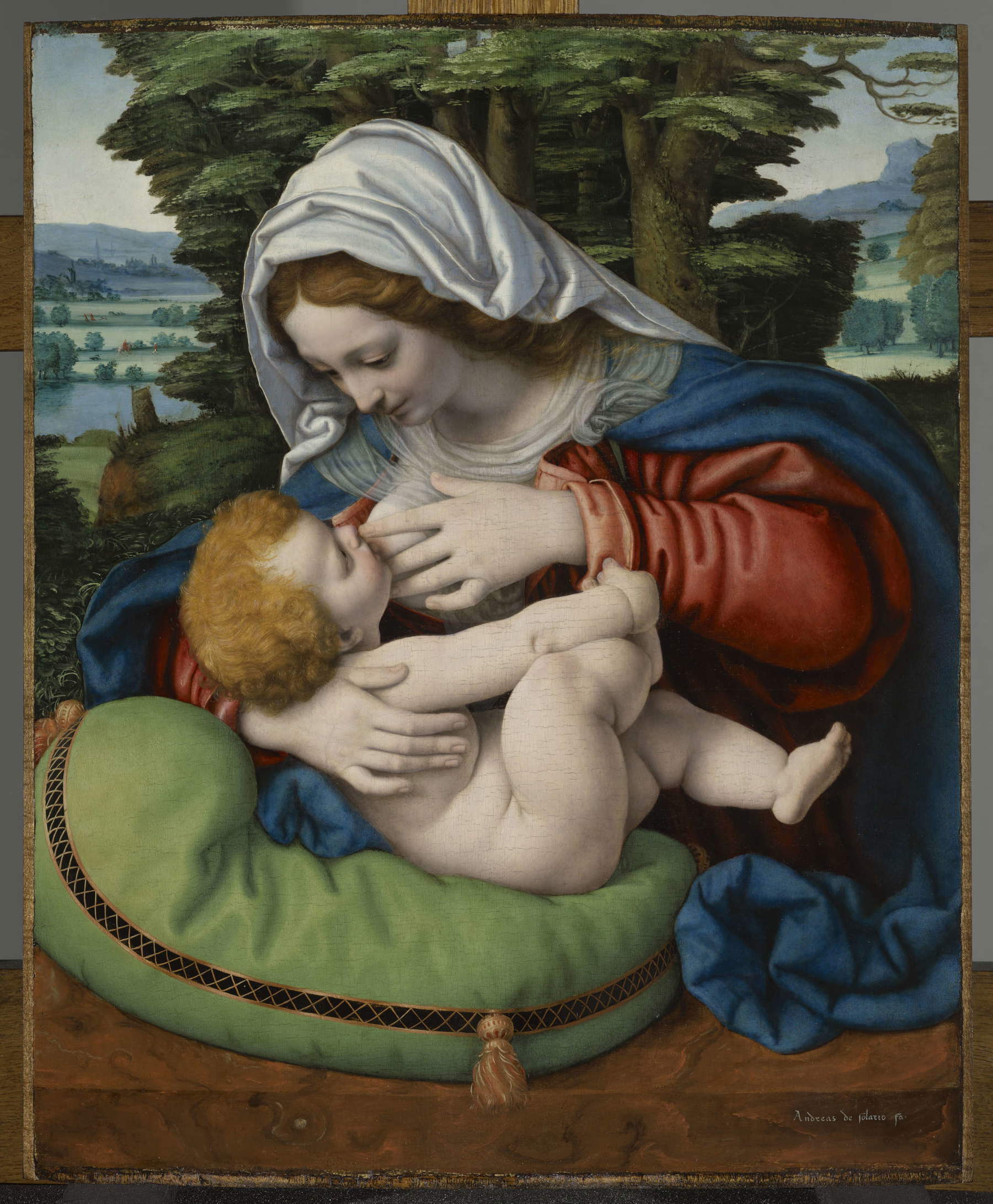
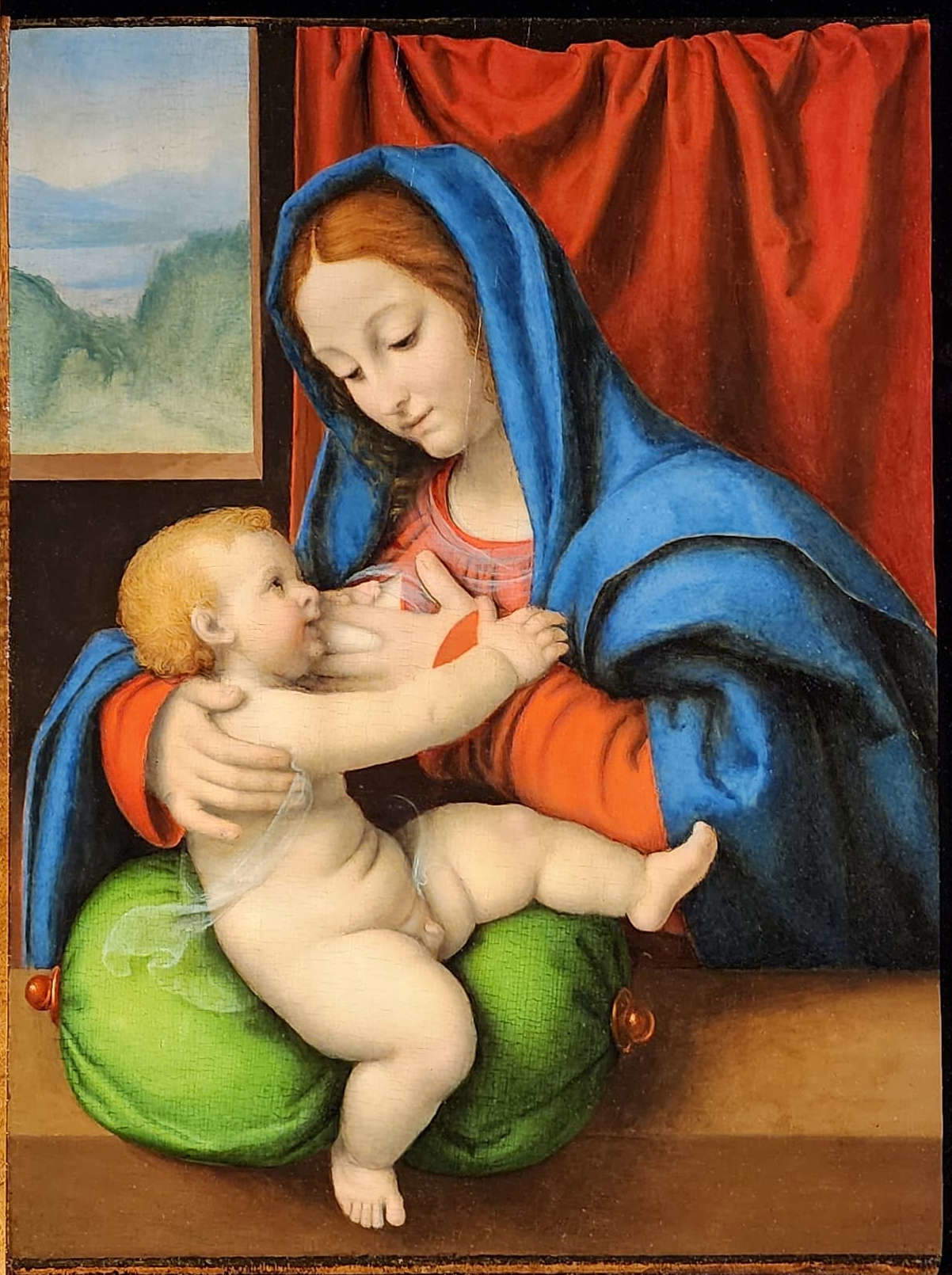
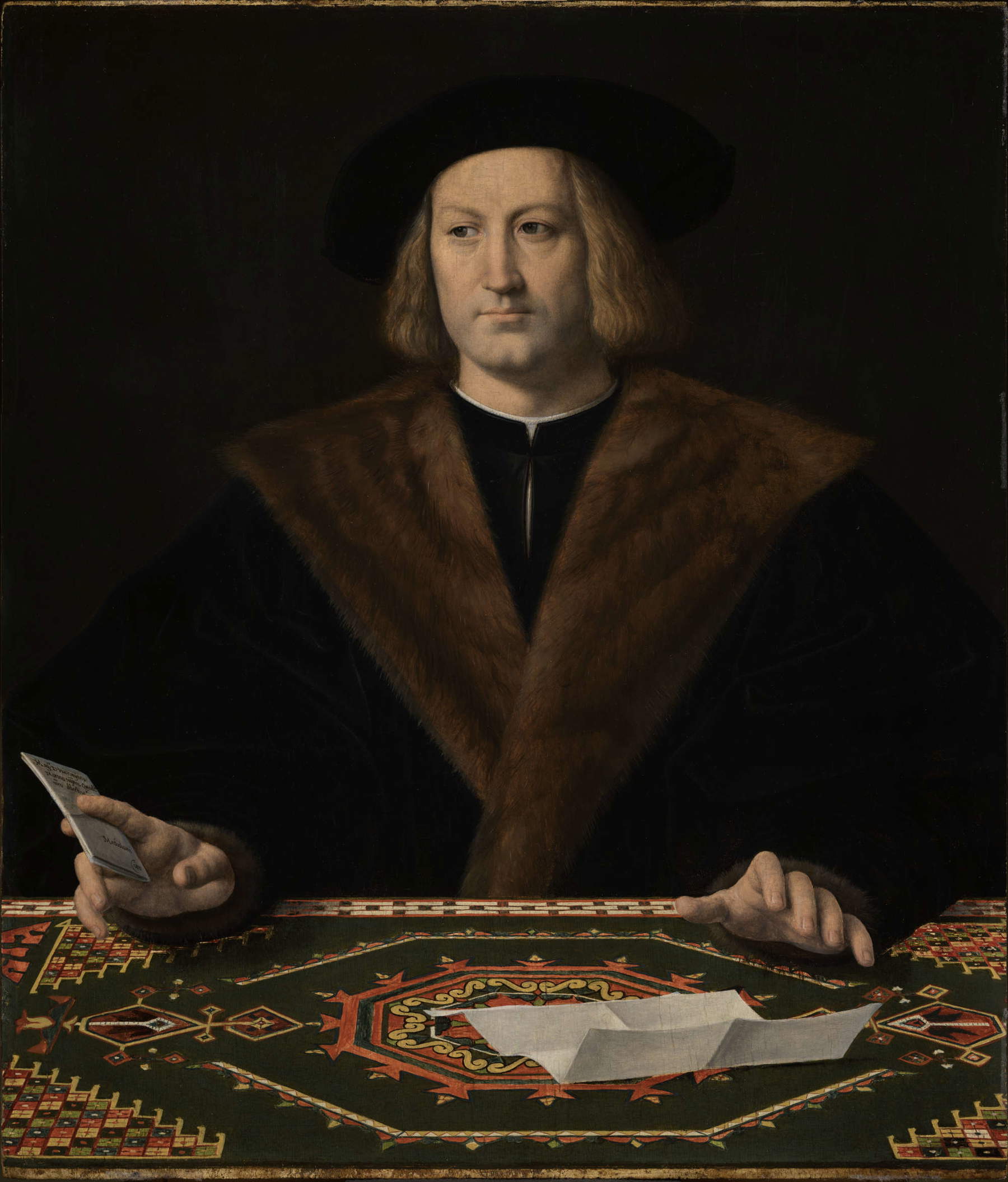
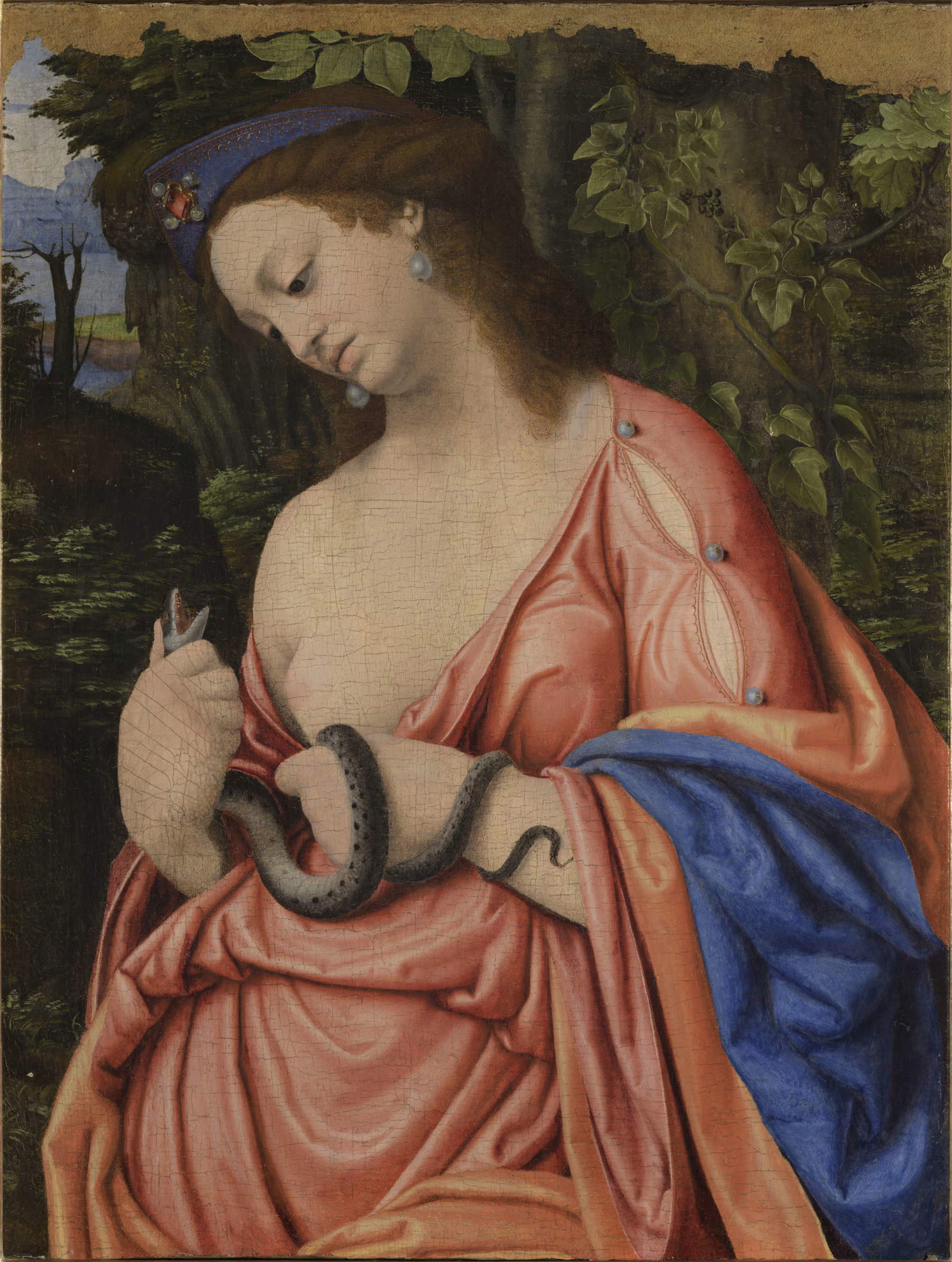
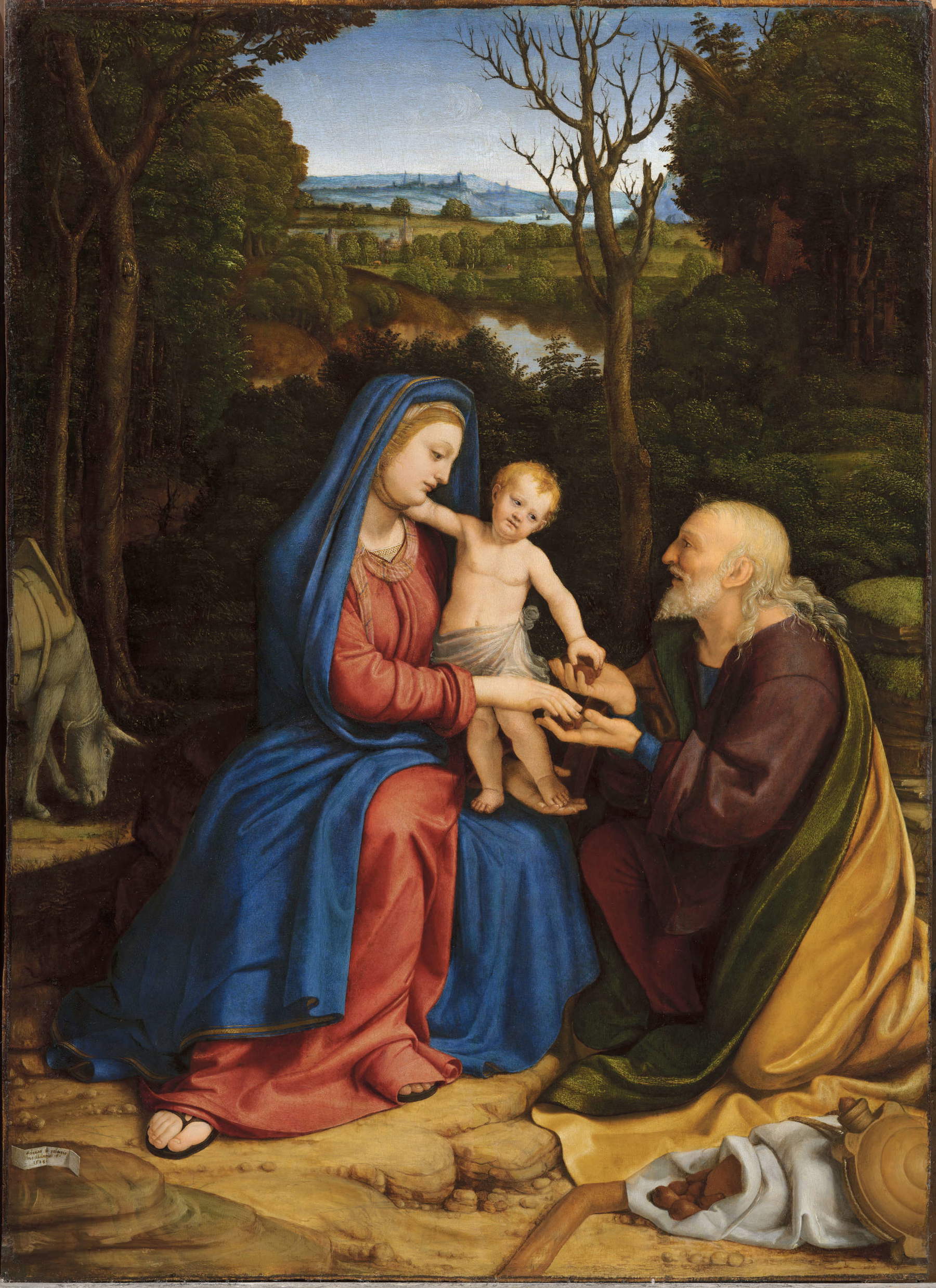
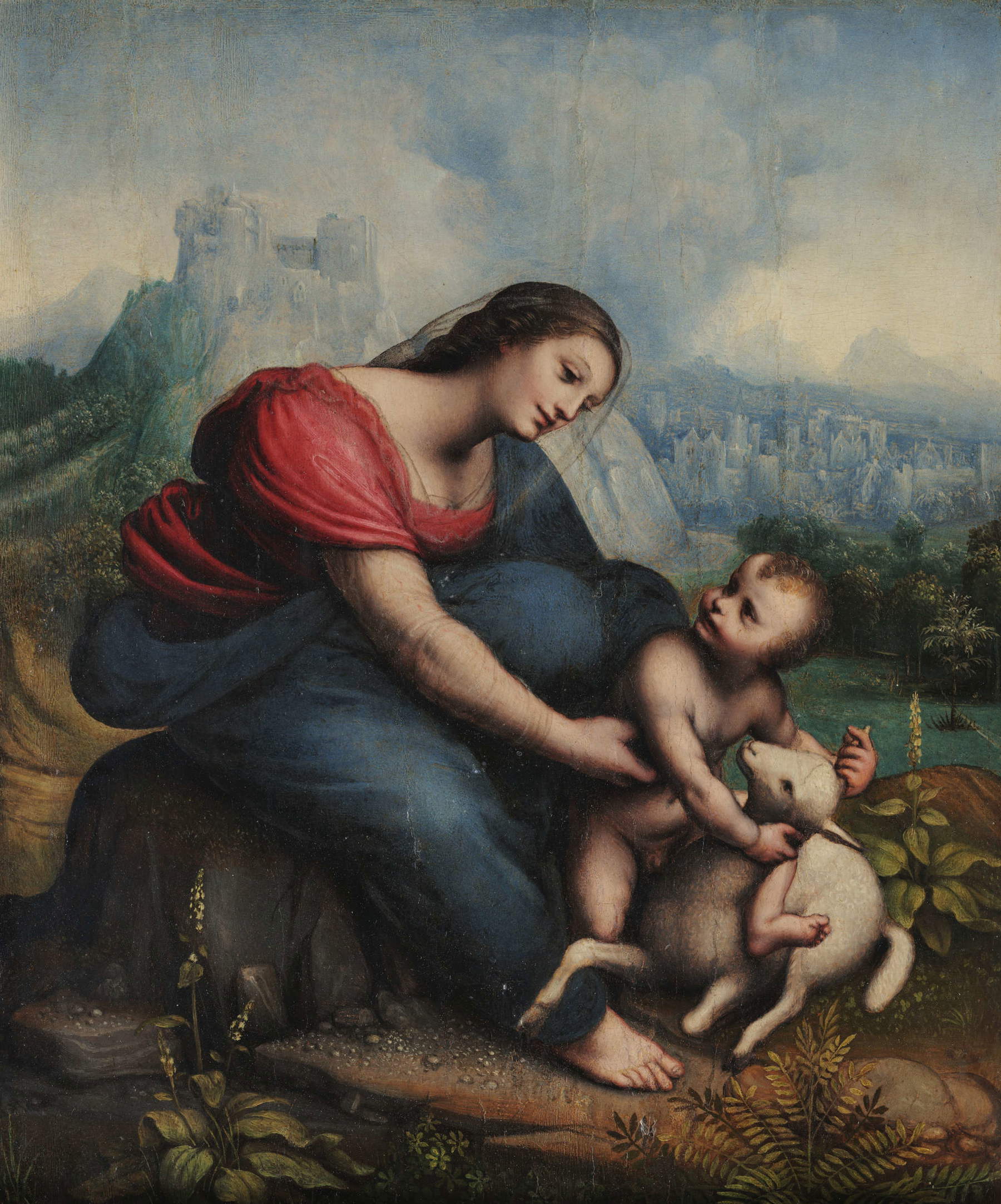
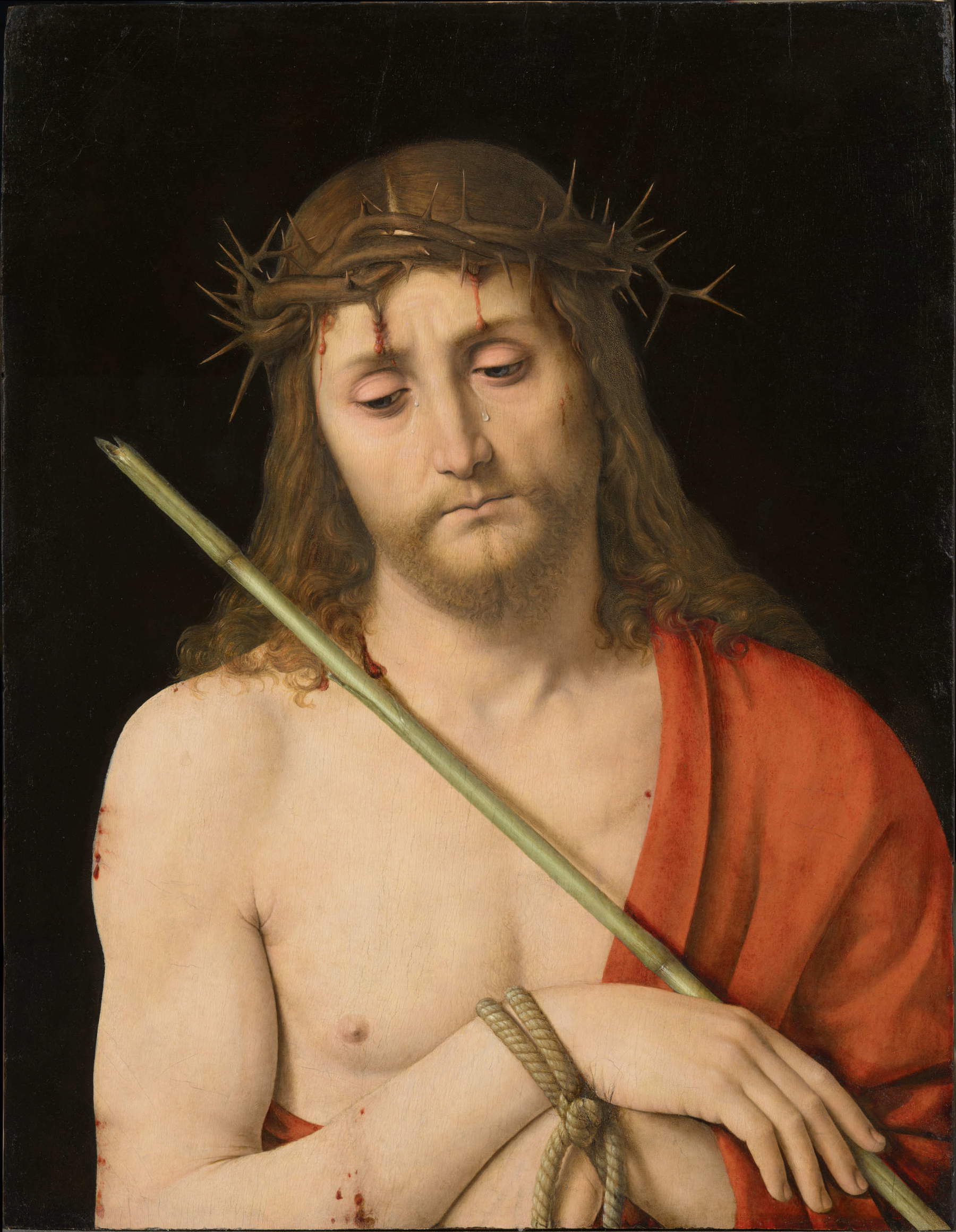
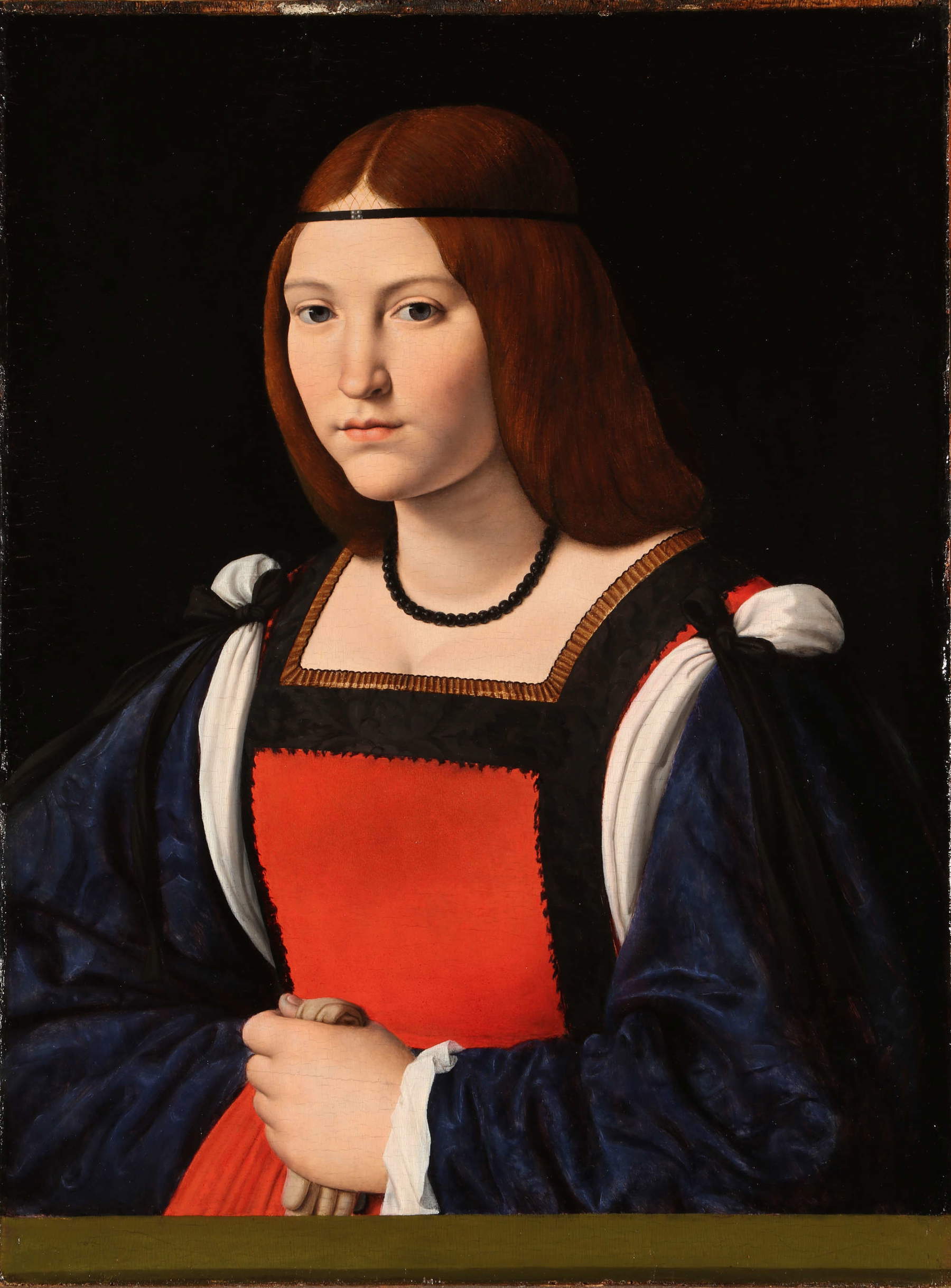
Magnetic ending, then, for an intelligent exhibition that is small in size and therefore knows no moment for lapses in attention. Almost all of Andrea Solari’s work is gathered at the Poldi Pezzoli, except for that which could not be moved, such as the Crucifixion from the Louvre, which remained in France for reasons related to its state of preservation, or such as the large altarpiece ofthe Assumption of the Virgin from the Certosa di Pavia, which was rightly left on the altar that houses it. This is, moreover, the only work by Solario mentioned by Giorgio Vasari, who refers to the Milanese painter as “Andrea del Gobbo,” after the nickname of his brother Cristoforo who was known, precisely, as “the Hunchback.” Confusion over his identification, moreover aggravated by the names by which the artist himself signed himself (alternately “Andrea de Solario” and “Andrea Mediolanensis,” as seen above), also contributed in part to tarnishing his fame. A fame that the Poldi Pezzoli is now wisely relaunching, responding to a “challenge,” as director Alessandra Quarto called it, because it is not easy to set up such an exhibition, the result of ’commitment and lengthy research, with a duly calibrated restoration campaign, on an artist little known to the public, when the trend is turning in the other direction and projects of even the best-known and most visited museums tend to converge on exhibitions devoted to hit parade names, with projects of a level that is anything but sublime. Here, however, the opposite happens. The exhibition on Andrea Solario is engaging, inviting, seductive as per its title, correct in its dimensions, strong in a well-focused selection of works, arranged along a shrewd, masterful scansion, punctual in its comparisons, precise in its apparatuses that do not overwhelm the works as is often the case, but rather urge the public to linger on the images. An exhibition that offers the public a chance to really rediscover in detail Andrea Solario, a little-known master, a great Milanese painter, a virtuoso of color, the artist who was the bridge between Lombardy and the Veneto at the beginning of the 16th century. An exhibition that, without a doubt, bids to be considered one of the best of this 2025.
The same precision of the exhibition is to be found, then, in the excellent catalog edited by Dario Cimorelli, which in fact takes the form of a monograph on the artist, with the two pleasing introductory essays by the curators, and with the detailed sheets devoted to the works, for each of which the entire critical history is minutely specified. Curious, finally, is the appendix devoted to Robert Wilson, the American theater director who, moreover, in recent days, inaugurated this year’s edition of the Salone del Mobile with a (rather questionable, in all frankness) illumination of the Pietà Rondanini: Coming out of the exhibition, after passing through the curtain that, like a curtain, divides the spaces of the temporary exhibitions from those of the permanent collection, one immediately comes across the three Lady Gaga Portraits that Wilson granted for the exhibition: they are the video portraits of the American singer in which Stefani Germanotta’s face merges with Solario’s Head of the Baptist that the public has seen in the exhibition. Wilson made them for a 2013 solo exhibition of hers at the Louvre. Pop reinterpretation of a Solario masterpiece for an unexpected and pleasantly unconventional exhibition closing.
Warning: the translation into English of the original Italian article was created using automatic tools. We undertake to review all articles, but we do not guarantee the total absence of inaccuracies in the translation due to the program. You can find the original by clicking on the ITA button. If you find any mistake,please contact us.





